Is Dollar Cost Averaging a Good Investment Strategy?
Dollar Cost Averaging is easy to do, and it could be the most profitable and low-risk strategy in the long term. Here’s why.
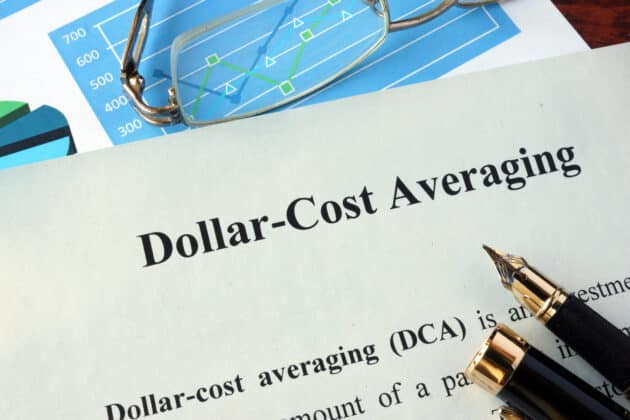

Dollar Cost Averaging seems like magic. Its basic principle can appear counterintuitive at first. Yet, it’s been proven to help investors start their investment journey, reduce their risk, while also earning them a decent return.
So, why is Dollar Cost Averaging a good investment strategy? In this article, we’ll uncover the secrets of Dollar Cost Averaging, through thought experiments and simulations.
To be more objective, this article will also discuss the limitations of Dollar Cost Averaging, particularly in certain market conditions.
So, what is Dollar Cost Averaging?
Basically, with Dollar Cost Averaging, you do the following:
- Buy a particular asset at any given price.
- Invest (roughly) the same amount of money each time.
- Optionally, invest at a consistent time interval.
Looking at face value, that is not much of a strategy — as in, there is not much “thinking” involved.
This is contrary to the belief that “good investing” must be actively managed and shouldn’t be left on auto-pilot. After all, in most financial markets, prices tend to fluctuate to a certain degree. Therefore logically, active management is “responsible investing”, is it not?
Would it be better to learn the price patterns of a particular asset, and buy it in large amounts when the asset is cheap? In March 2020, the general financial market experienced a crash. Those who “bought the dip” saw their portfolio’s net worth increase at an unusually faster rate.
Regardless, no matter how you choose to invest, all strategies must bow down to one basic rule of investing — buy low, sell high.
Read more in detail: Dollar-Cost Averaging: Crypto Investing Made Simple.
Back to the basics of investing
Dollar Cost Averaging implies that at certain times, you’d buy the asset at a higher-than-average price. You also can’t guarantee that the sell price will be higher than the highest you’ve paid for that particular asset.
Luckily, you don’t have to wait until you can make a profit on all your purchases. Given a sell price, some assets may sell at a loss. However, if the majority of assets sell at a profit, you’re in for some investment gains.
The trick is to make sure that the average buy price is lower than the market price. The average buy price is calculated as follows:
Average buy price =
Total invested money ÷ Total amount of an asset
If you want to know how much profit you’d have, given the market price, average buy price, and total invested money, here’s the formula:
Profit =
(Market price ÷ Average buy price) – 1 x (Total invested money)
How Dollar Cost Averaging works
This section explains how Dollar Cost Averaging can affect the average buy price in a volatile market. First, take a look at the chart below. This is the price chart of a fictional asset, with each movement simulated using a random function.
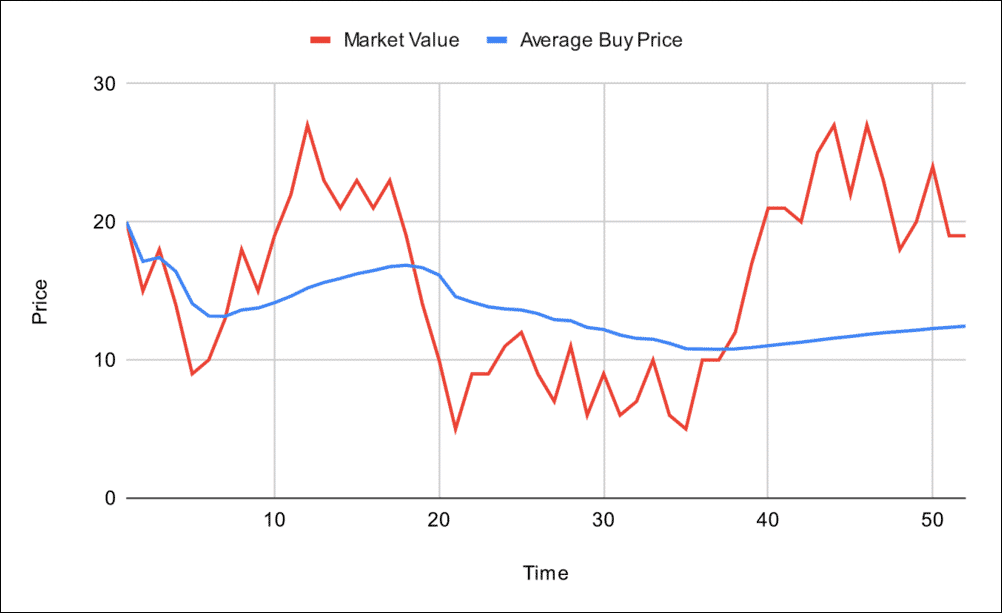
An investment using Dollar Cost Averaging will allow you to spread out your investment risk. It avoids spending all your investment budget on a single price at one point. From this chart, we can take a few key observations:
- If you happen to start investing at a high price, and the market price falls, you will still have enough money to buy the asset at a lower price.
- If the market dips even further, you’ll be able to catch an even bigger “discount”. This helps lower your average buy price (shown in blue).
- The price may recover eventually, even surpassing the price at which you bought it the first time. When that happens, your average buy price will slightly increase as you buy the asset at a much higher price. Selling the asset at this period can also lead to a profit.
- At Time 20, notice that the simulated market crashes. So too, does the average buy price dip, assuming that you continue Dollar Cost Averaging. Of course, as the market price is below the average buy price, you’d experience a loss if you sell at this time.
- Until around Time 35, the simulated market consolidates and moves sideways. If you continue to invest during this market condition, your average buy price will gradually decrease.
- From Time 35 onward, the simulated market burst into a bull run, but the average buy price seems resistant to change.
Let’s consider the last point. With Dollar Cost Averaging, why does the average buy price decrease faster when the price falls, but is resistant to change when the price rises?
Make investing in crypto super simple. Here’s how to set up automatic purchases with Auto-Buy.
The inverse relationship between price and quantity bought
The ‘inverse relationship’ is a fancy way of saying that the cheaper the price gets, the more quantity of an asset we can accumulate. This fact seems rather obvious, but what can we learn from this?
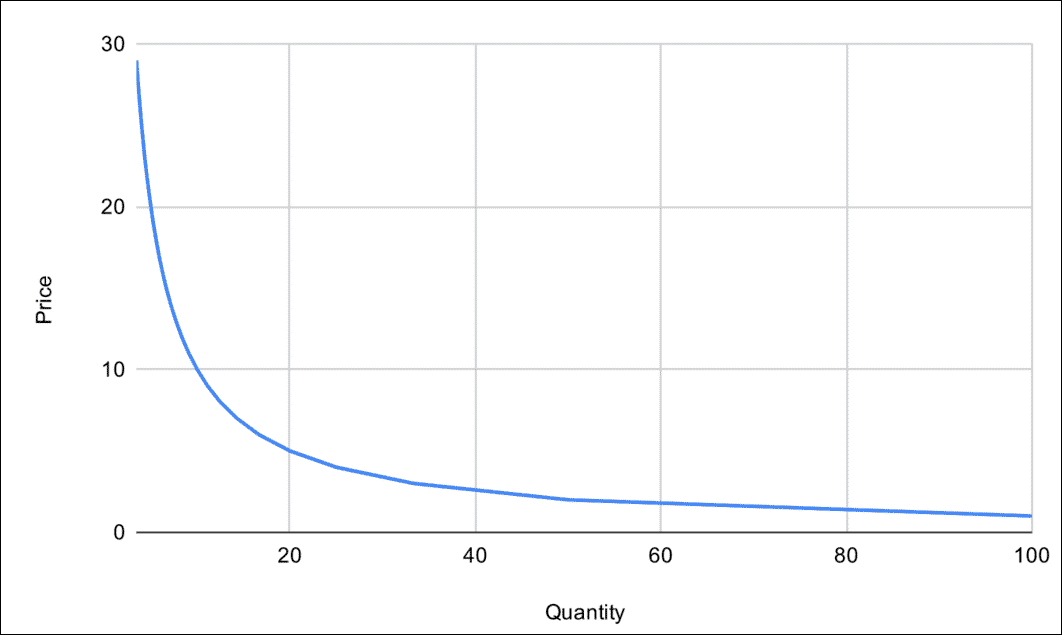
At a lower market price, we can invest in more of the same asset even if we use up the same amount of money. Recall that:
Average buy price = Total invested money / Total amount of asset
If the total amount of assets increases at a faster rate, while the total invested money increases at a consistent rate, the average buy price decreases.
What happens when the asset becomes more expensive? The increase in total money invested stays consistent (since we’re using Dollar Cost Averaging). The increase in total amount of asset is not necessarily slower than the former — it’s just relatively slow.
In other words, the effect of a low market price on the average buy price is much stronger than the effect of a high market price.
Dollar Cost Averaging makes it relatively easy to lower your average buy price, increasing your potential for higher returns.
Simulations on Dollar Cost Averaging
Below are some thought experiments which exaggerate price behavior. Our goal is to dispel some wrong expectations on how the average buy price would behave in various markets.
The bullish market trend
The first example shows what happens if an asset’s price consistently rises. Many people believe that Dollar Cost Averaging halves the potential earnings of an investment.
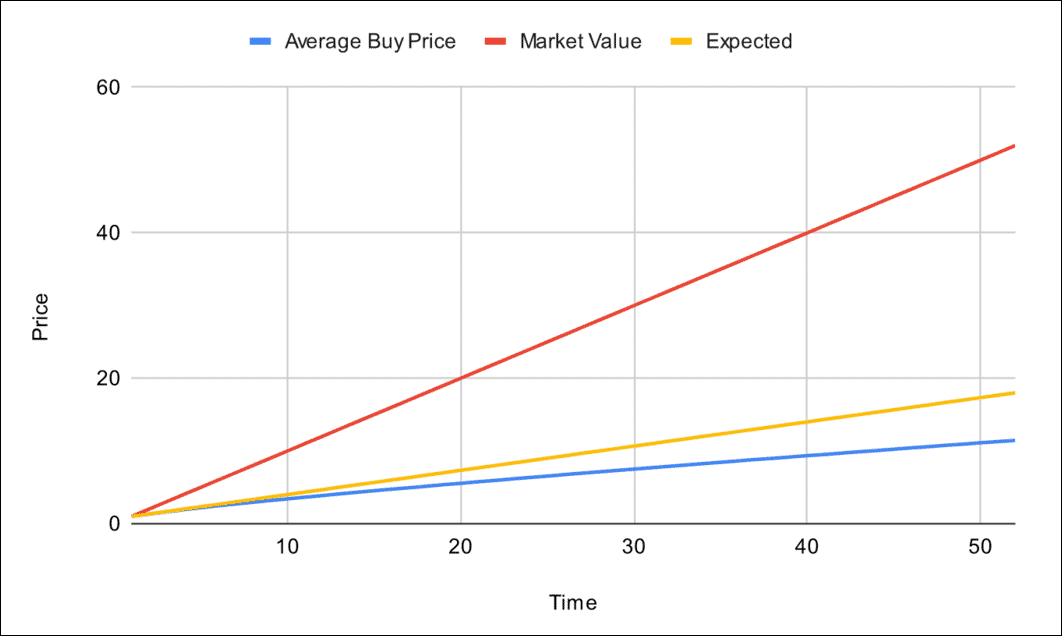
However, the chart above shows that the actual average buy price (blue) climbs at a much slower rate compared with the expected rate (yellow). The expected rate is exactly half the rate of price increase. This means that Dollar Cost Averaging allows for greater potential returns, even in a bullish market.
The market reversal trend
Now, let’s simulate the case where the price falls and recovers to the same level. You may still hold the belief that Dollar Cost Averaging simply halves the rate of the market price movement.
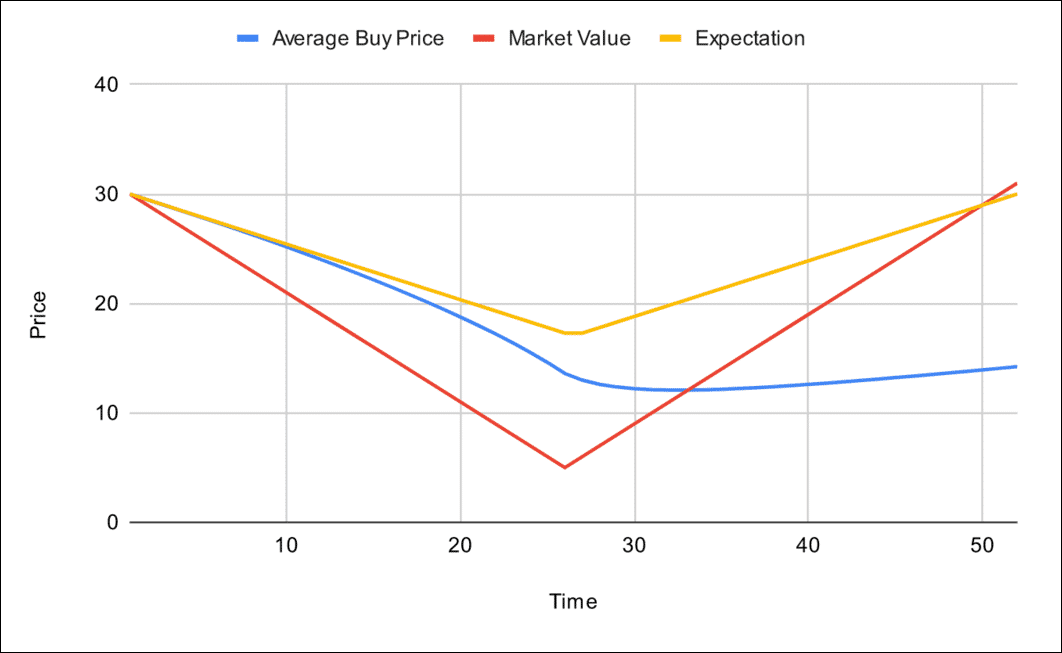
Again, Dollar Cost Averaging actually makes it easy for investors to get a more favorable position for a higher profit. In this thought experiment, the price of the asset loses as much as 83% of its market value.
If you continue to invest anyway, your average buy price (blue) will experience increasing weight from the cheap asset. You can almost see a small “bend” in the average buy price line, as the price hits the absolute bottom.
Afterwards, something seemingly miraculous happens — the average buy price stays at around Price 12, even after the price fully recovers.
The sideways market trend
Yet another impossible price chart makes for an interesting subject for our thought experiment. This time, the price moves sharply up and down in a regular fashion. You may expect the average buy price to fall at the exact middle, through the zig-zag pattern.
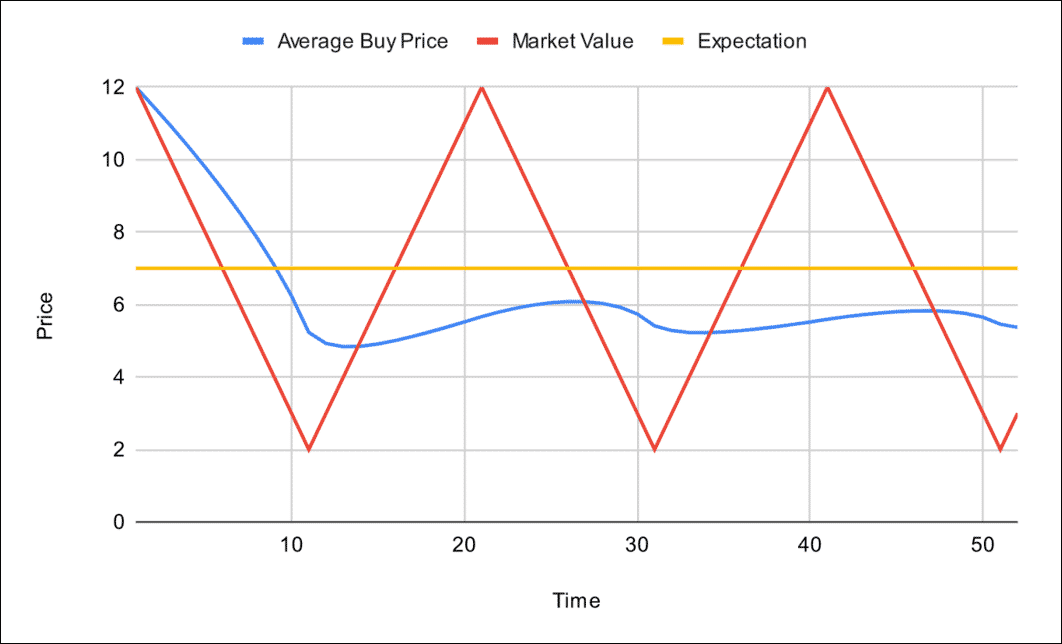
However, the simulation shows that even in this scenario, the average buy price favours a lower position. The multiple dips keep the average buy price low.
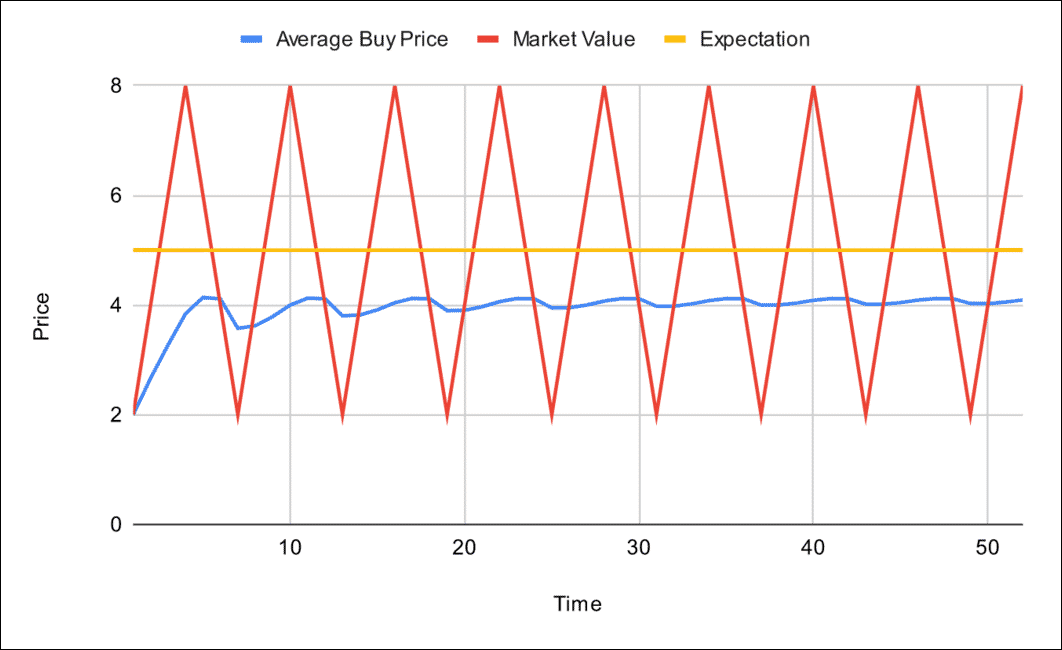
Here is another variant of the scenario. This time we start buying at the lowest price possible, and move the price more frequently. We see the same result — the average buy price is lower than the middle point of the zig-zag pattern.
The bearish market trend
Both beginner and advanced investors will at some point experience a dilemma during a bearish market. What happens if you continue to do Dollar Cost Averaging in spite of the price falling by more than 95%?
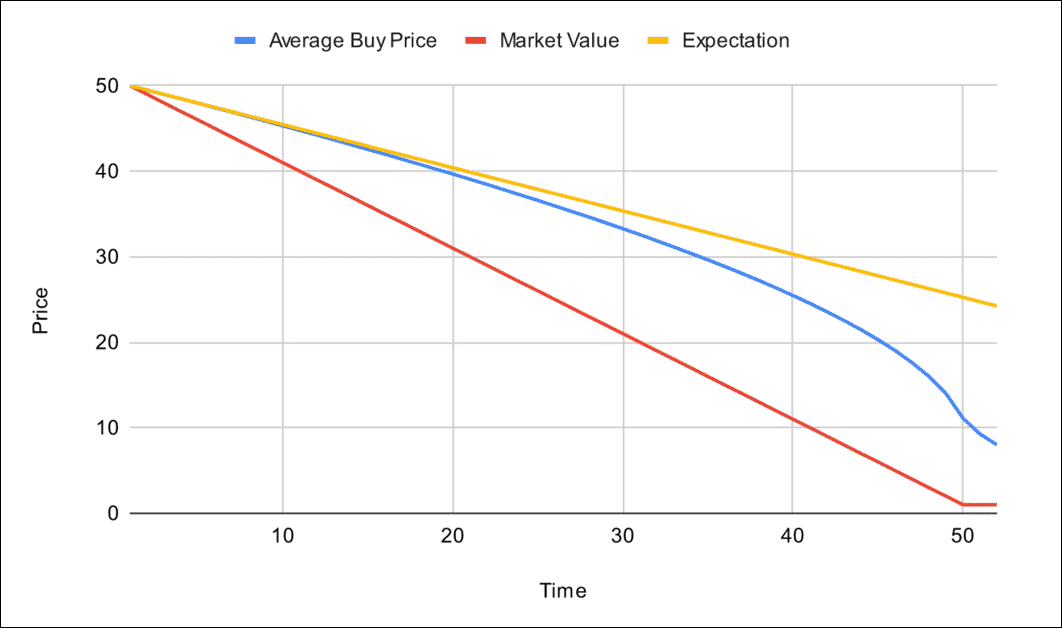
The yellow line represents a decrease that is half the rate of the decrease in market value. Due to the inverse law of price and supply, the amount of discounted assets can quickly outnumber those that were bought at a much higher price. This results in a faster decrease in average buy price (blue).
Of course, it’s very rare to find a determined investor who would keep investing even after the price has fallen greatly. The point of this thought experiment isn’t to suggest that you should do this. It’s rather to reassure investors that for a high-quality asset, falling prices are not to be feared.
Instead, you should see it as an invitation to earn potentially larger profits in the future.
Market high sell-off
A common pattern that we see in financial markets (especially in crypto markets) is a sell-off after reaching an all-time high. This usually happens after a period of overconfident buying behaviors among traders, which pushes the price towards unsustainable levels.
Our thought experiment will use a simple model. Just an upside-down “V” like the chart below:
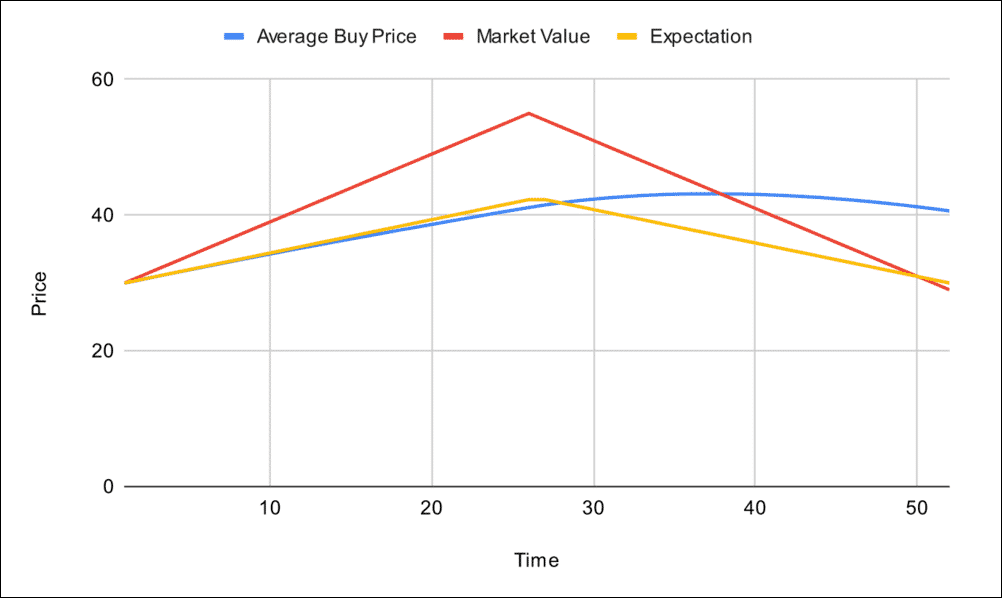
By now, it should be clear that the average buy price does not reflect half the rate of the price movement. With Dollar Cost Averaging, the average buy price tries to find a balance between the peaks and the troughs, while favoring a lower price.
When you invest in an asset, and this pattern occurs, there are two things you can do to increase your chance of getting a profit (or reaching a breakeven point):
- Make sure that you have enough funds to continue investing during a price correction or a bear market.
- Believe in the asset’s price recovery in the future.
You’d be surprised, but investing has less to do with being strategic about the timeframe you choose to buy. A common saying among investors is, “Time in the market beats timing the market”.
Investing is about being disciplined and consistent. Often enough, during a bear market, faith is what investors need to have to continue investing, even if seeing the red negative numbers is painful.
Why not use actual crypto prices in this investigation?
The short answer: It wouldn’t be a fair investigation!
If you start investing in any asset that has been doing extremely well, using Dollar Cost Averaging from any point in history will always lead to a profit. But hindsight is clear as day, and it’s difficult to predict the future, even for cryptocurrencies.
Extended bear markets (so-called “crypto winter”) do occur in some periods. We spot a few of them on Bitcoin’s price chart. After all, it’s the only cryptocurrency that has existed for the longest time. In Bitcoin, the following are considered bear market periods:
- July 2011 — July 2012
- December 2013 — December 2016
- January 2018 — June 2019
Below is the monthly candlestick chart for Bitcoin’s most recent extended bear market. The white line is the average buy price if we were to invest on the first day of every month from January 2018.
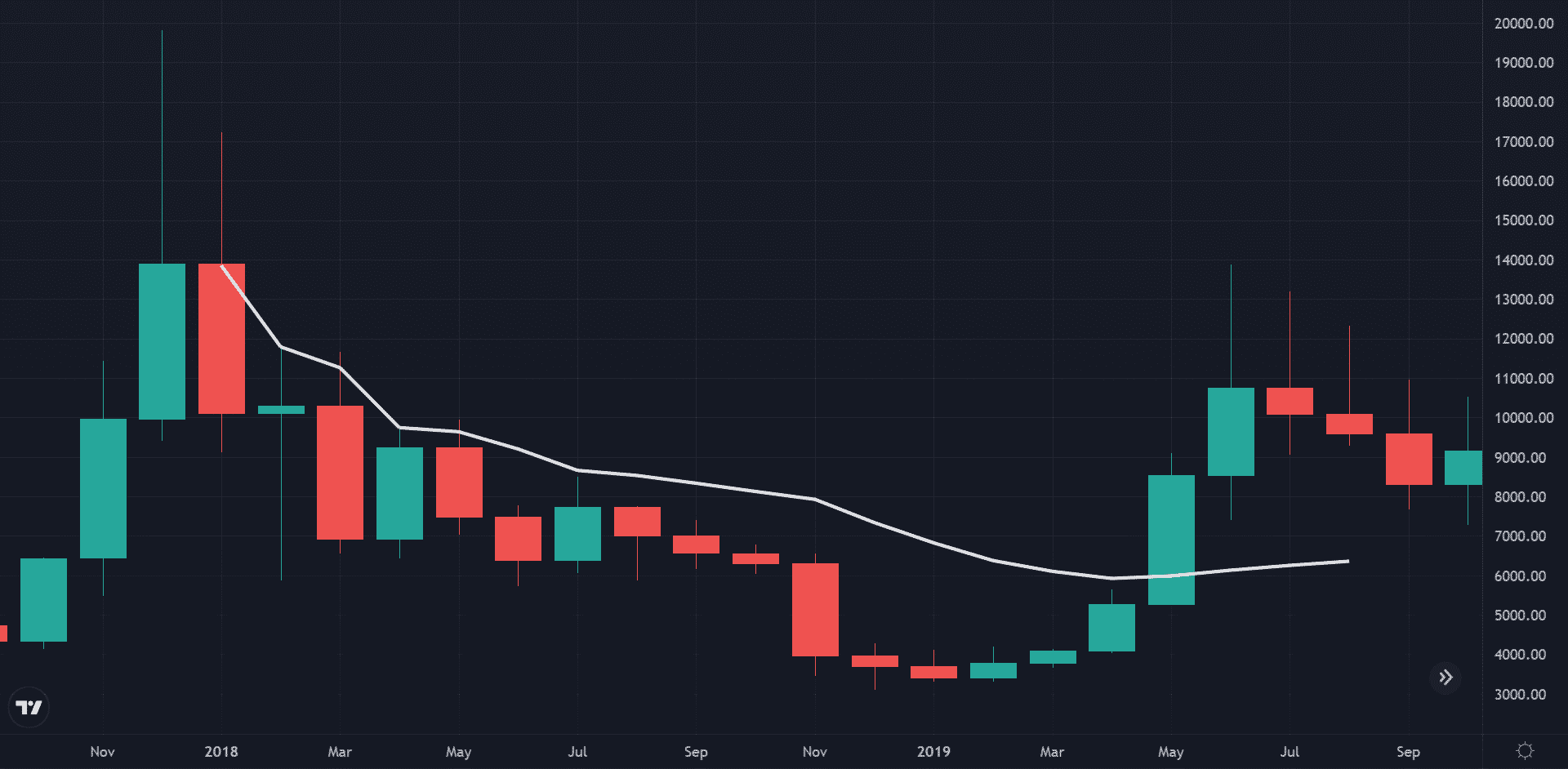
You can see that as Bitcoin gradually lost 70% of its value, the average buy price follows. However, the cryptocurrency gained a new footing in early 2019, and the price almost recovered to its January 2018 level.
Of course, you wouldn’t have to wait so long. Even if the price did not fully recover, Dollar Cost Averaging from January 2018 would put you back in position for profit at the end of May 2019.
Automate your crypto investment: Beginner’s Guide to Automating Your Crypto Orders.
So, is Dollar Cost Averaging a good investment strategy?
From the simulations, Dollar Cost Averaging seems like a fairly decent investment strategy, especially in volatile markets. It works well in both bullish and sideways markets.
In bearish markets, Dollar Cost Averaging is powerful at bringing down the average buy price. In such a scenario, investors will likely profit when the price recovers just slightly.
We’ve written a comprehensive investigation on extended crypto bear markets, and how to profit off of it.
Must read: How to Profit from a Crypto Market Rebound.
If this article has been helpful to you, help someone else today by sharing it!
Share to
Stay curious and informed
Your info will be handled according to our Privacy Policy.
Make sure to follow our Twitter, Instagram, and YouTube channel to stay up-to-date with Easy Crypto!
Also, don’t forget to subscribe to our monthly newsletter to have the latest crypto insights, news, and updates delivered to our inbox.
Disclaimer: Information is current as at the date of publication. This is general information only and is not intended to be advice. Crypto is volatile, carries risk and the value can go up and down. Past performance is not an indicator of future returns. Please do your own research.
Last updated September 5, 2023





